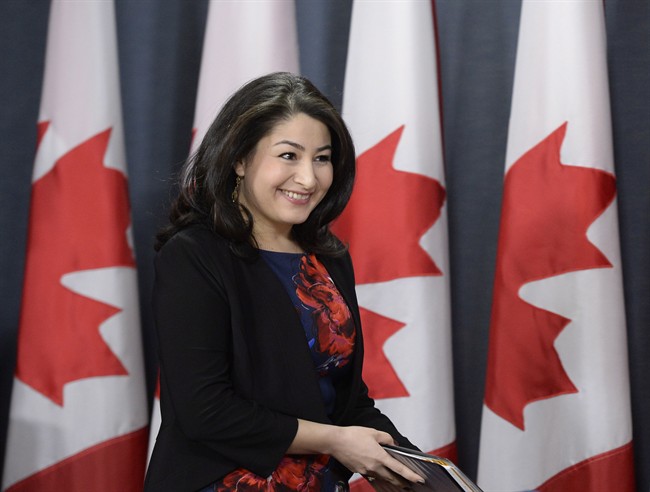On election night 2015, when Justin Trudeau was running for the office of prime minister, he boldly declared himself a feminist. A month later, once in office, he assembled a cabinet that included an equal number of male and female ministers. When asked about his decision to appoint so many women, he famously quipped, “Because it’s 2015.”

For the most part, Canadians have loudly applauded our prime minister and his brand of unabashed feminism, making him an icon for gender equality on the international stage.
READ MORE: Redefining the f-word: What does feminism look like today?
It’s reflected in the numbers, too. An Ipsos poll commissioned by Global News found that 61 per cent of Canadians believe that gender equality in our country has progressed in the last 25 years. Notably, those percentages rose to 65 in British Columbia and Ontario. (Alberta had the lowest number — 50 per cent.)
But considering that women still make 74 cents to every dollar that a man earns and gender-based violence affects approximately half of all Canadian women, it begs the question of just how far we’ve come in terms of equality.
“It’s important to recognize the hard-won gains of the past few decades and of our current government,” says Maryam Monsef, Minister for the Status of Women. “We are fundamentally protected against discrimination under the Charter of Rights and Freedoms, which is unique to Canada. For the first time, the 2017 budget includes gender recognition which influences how we tax programs and policies. We’ve spent several nights this week in graduation ceremonies where more women than men are graduating and entering the workforce. That’s all part of progress.”
It’s true that women are generally more educated than men in this country — women make up 60 per cent of university grads — and there is an influx of women into the labour market (82 per cent versus 65 per cent in the 1980s). But considering that women on average put in twice as many hours as men in unpaid work because they bear the brunt of child and elderly care, those rose-hued visions of a country based on equality start to change colour.
We have a significant wage gap
“Nearly half of all Canadians believe the wage gap is one of the biggest roadblocks to equality,” says Paulette Senior, president and CEO of the Canadian Women’s Foundation. “While one of the major strides we’ve made is that a lot more women graduate from post-secondary institutions, when it comes to accessing high-level jobs like vice-president, CEO and other key leadership positions, we’re not there. Despite performing better in education, it hasn’t resulted in women sitting at those key decision-making tables.”
In 2015, 12 per cent of board seats of TSX-listed companies were held by women and 29 per cent of the companies had one female director, while nearly half had no women on their boards at all. Of the 710 companies, only five reported having a board comprised of 50 per cent (or more) women.
WATCH BELOW: Gender equality in Canada
The gender wage gap is perhaps the broadest of issues that need addressing, especially since its repercussions are felt across various ages and social demographics. (Especially among Indigenous and racialized women and women with disabilities, who earn even less — 67 cents for every dollar, Senior says.)
“We know that women who are seniors are at higher rates of poverty because their pensions are lower and they live longer, so they have to stretch their money out for a longer period of time,” says Jessica Mustachi, Ontario co-ordinator of Campaign 2000, a national educational movement to end child poverty.
She points to the wage gap as also impacting women’s ability to enter the housing market, which is made even direr when a woman is in a violent situation and can’t afford to distance herself from an abuser because she can’t pay rent.
The effects of gender-based violence are far reaching
A survey conducted by the Canadian Women’s Foundation in May found that four out of five Canadians believe the next generation of women is likely or more likely to experience sexual assault, and 49 per cent of respondents feared that the country will not make more progress in the area of gender equality.
READ MORE: Bulk of funds for Canada’s gender-based violence strategy going to centre of excellence
“There could be a number of things happening to result in this,” Senior says. “It could be influenced by what’s happening in the United States, or it could be what’s happening in our own society. We still have judges in Canada who say outrageous things like you should keep your knees together to avoid being raped. It is perhaps a realization that we’ve taken things for granted in Canada.”
Inaccessible child-care impacts the economy as much as it does women and children
Child-care costs in Canada are among the highest in the world, according to the Organization for Economic Co-operation and Development, which forces some families to choose between having two working parents or one stay at home.
And since the bulk of child-care still largely falls to the woman — in 2010, women spent an average of 50.1 hours per week on child care versus 24.4 hours spent by men — it means fewer women in the workplace and a loss to the nation’s economy. Between 1976 and 2015, mothers whose youngest child was under the age of six consistently had the lowest employment rates.
“Universally accessible, low-cost subsidized child-care needs to be adopted across the country. We can look to Quebec to see how it’s working,” says Sheila Block, senior economist at the Canadian Centre for Policy Alternatives. “It not only lowers the cost of child-care but it also increases the quality. We know that not-for-profit child-care is really crucial to the safety and development of children.”
Block points out that already women put in twice as many hours as men in unpaid work.
“When government spending falls behind in health care and child care, the burden falls on women and hampers their part in the labour market,” she says.
READ MORE: Child care costs in Canada: The most and least expensive cities
This is one area, Monsef says, where the current government is already making significant strides.
“The 2017 budget made a commitment of $7 billion to a National Framework on Early Learning and Child Care, which is historic for Canada. This includes a framework specifically for Indigenous families,” she says.
Monsef also pointed to the successful implementation of the new Canada Child Benefit program and said it “recognizes that Canadian families don’t come in one shape or form, including single mothers who are in need of support.”

How can we effect more change?
With more women graduating from higher learning institutions, the hope is that they’ll begin to populate the decision-making roles that can truly have an effect on gender parity.
“We need to have more women on boards and heading up corporations,” Senior says. “This is also a huge opportunity for Canada to take the lead globally on issues of gender equality. Our prime minister has declared himself a feminist and now he needs to back it up with action through public policy and resources to address these issues.”
It’s also an opportunity for the country to put more women in political positions.
“If you know a woman who would make a terrific representative for your community or municipality, ask her to run,” Monsef says. “And then ask her 14 more times, because that’s how long it could take to convince her she has what is needed.”









Comments